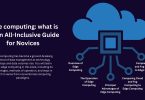Businesses operating in the big data space must identify and make good use of the primary sources that add to the large and diverse data landscape. Organizations need to assess the usefulness and relevance of various data sources as they move through them in order to fully utilize big data for analytics and insightful analysis.
The top 5 sources of big data are as follows:
- Media as a Crucial Source of Big Data:
Social Dynamics: Social media systems record users’ dynamic interactions in addition to acting as simple data repositories. From likes and comments to shares and trends, organizations obtain deep insights into consumer behaviors and attitudes.
Perspectives on Images and Multimedia: The incorporation of images, movies, audios, and podcasts adds a multi-dimensional layer to the data. Because of the comprehensive picture of user involvement that this multimedia feature offers, organizations are able to adjust their strategy appropriately.
- Cloud as a Flexible Source for Big Data:
Scalability and Economical viability: The two most important aspects of cloud computing are scalability and economic viability. It supports enormous volumes of data and provides an affordable solution. Depending on their data needs, businesses can scale up or down without incurring extra fees.
Real-time Collaboration: Cloud-based solutions enable teams to collaborate in real-time, guaranteeing important departmental insights are shared without interruption. This collaborative feature speeds up the entire analytics lifecycle and improves decision-making processes.
- The Web as a Vast Source of Big Data:
Global Accessibility: Regardless of geographic limitations, organizations may access a vast pool of data thanks to the internet’s global reach. Because of its accessibility, businesses with a global presence can gain valuable insights from a variety of markets.
User-generated Content: A vast amount of content is created by users on websites such as Wikipedia, forums, and review sites. This content, which is frequently accessible for free, is an invaluable tool for companies looking to comprehend trends and public opinion.
- IoT as a Priceless Source of Big Data
Real-world Insights: IoT-generated data goes beyond the digital sphere to offer real-time perceptions into how physical things are used and function. This real-world data, which provides precise information for well-informed decision-making, is vital for a variety of industries, including manufacturing and healthcare.
Predictive analytics: Businesses may anticipate future trends and events in addition to understanding existing scenarios thanks to the constant influx of data from IoT devices. This predicting skill enhances strategic planning and risk management.
- Databases as a Hybrid Source for Big Data:
Integration for Detailed Analysis: A comprehensive data ecosystem is produced by integrating classic and contemporary resources. By combining unstructured data from modern sources with structured data from historical systems, this hybrid model enables firms to conduct more comprehensive analyses.
Agile Response to Business Needs: Businesses are able to react quickly to changing data requirements because of the agility hybrid databases offer. Whether it’s collecting historical insights or evaluating real-time data, the hybrid approach accommodates varied business objectives.








